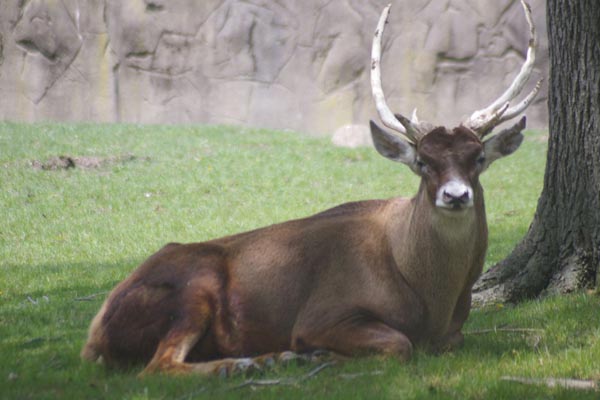WHITE-LIPPED DEER
Cervus albirostris
Physical Description
The White-lipped Deer is also known as Thorold’s Deer, the Grass or Rock Deer, the Yellow Deer, and the White-faced Maral. The White-lipped Deer is a large, strong deer. The Deer’s name originates from its white lips. The inside of the White-lipped Deer’s ears, the tip of its muzzle, its throat, the underside of its chin, and the inner side of its legs are also white. The Deer’s belly is cream to greyish white and the Deer’s rump patch is reddish brown. The rest of the White-lipped Deer’s body tends to be dark brown in the summer and light buff to greyish brown in the winter.
However, the colour of the Deer’s coat varies somewhat according to gender, season, and, possibly, locality.
The White-lipped Deer’s coat is coarse and stiff, with hollow hairs (like those of the Bharal, or Blue Sheep) that provide the Deer with an insulating layer of warm air. The coat lengthens in the winter. The hair in the center of the White-lipped Deer’s back grows in the direction opposite to that in which the surrounding hairs grow, making it look as though the Deer is wearing a saddle. The light coloured band near the tips of the White-lipped Deer’s dark hairs gives the animal a grizzled appearance.
The White-lipped Deer has broad, rounded hooves like those of cattle. These hooves help the Deer to climb steep, uneven terrain and make a clicking sound as they hit the ground. The White-lipped Deer has excellent eyesight. Stags have large, somewhat flattened antlers, with five to six tips. Antlers are white, or, rarely, light brown, and grow as long as 130 centimetres (4.3 feet) and as heavy as seven kilograms (15 pounds).
Does have a tuft of hair on the top of their heads. The White-lipped Deer’s ears are thin and pointed. Stags stand about 120 to 140 centimetres (3.9 to 4.6 feet) tall at the shoulder and weigh 180 to 230 kilograms (197 to 507 pounds). Does stand about 115 centimetres (3.8 feet) tall and usually weigh less than 180 kilograms (197 pounds).
Habitat
The White-lipped Deer inhabits coniferous forests, willow and rhododendron scrub, and alpine meadows, from 3,500 to 5,000 metres (11,500 to 16,400 feet) in elevation. The Deer also inhabits arid, treeless mountain ranges. The White-lipped Deer is endemic to the Tibetan Plateau. The Deer occurs in low densities within its habitat range, which, though extensive, has become highly fragmented. The White-lipped Deer is currently found in Tibet, east of Lhasa into western Kham (Sichuan Province), and in eastern Amdo (the eastern two-thirds of Qinghai Province into Gansu Province). Though the Deer is spread over a large area, it occurs at low densities and its populations are highly fragmented.
Eating Habits The White-lipped Deer’s diet consists mainly of grasses, including Stipa, Kobresia, and Carex spp. The Deer may also eat sedges and herbs.
Behaviour and Reproduction
The White-lipped Deer is active during the day. The Deer can swim. Males and females live separately for most of the year. Young males form herds of up to eight members, while older males are solitary. Pregnant females, females with their young, and preadult females live together.
During the rut, which takes place from September to November, males and females commingle, forming mixed herds that consist of an average of 50 deer but sometimes as many as 200 to 300 deer. These mixed herds usually include one to eight stags. Rutting stags compete with each other for access to females and try to collect harems. Stags lose weight during the rut because they expend large amounts of energy mating and fighting with each other.
The White-lipped Deer’s gestation period is 225 to 250 days. Does give birth from late May to July, each mother to a single fawn. Mothers move their fawns to more sheltered areas two to three days after giving birth. Fawns are weaned by about one year of age. Young males join male herds after they are weaned, while young females, though independent, remain in their mothers’ herds. White-lipped deer reach sexual maturity at about 15 months of age.
The life span of the White-lipped Deer is 16 to 18 years. The Deer’s natural predators include wolves and snow leopards. The White-lipped Deer, a fast and agile runner, will flee from danger or use its sharp hooves to defend itself. If a mother observes a predator approaching her infant, she may run in the opposite direction to divert the predator’s attention away from the infant. The White-lipped Deer is extremely shy of humans, since humans have hunted it for decades.
Present Status
The White-lipped Deer is categorized as Vulnerable in the 2003 IUCN Red List of Threatened Species. The White-lipped Deer is under first class protection in China. In 1993, the population of White-lipped deer was estimated at between 50,000 to 100,000.
Threats to Survival
The White-lipped Deer is hunted for food and to obtain its antlers and other body parts for use in traditional Chinese medicine. The Deer must also compete with increasing livestock populations for forage. Another threat to the White-lipped Deer’s survival is hybridization. There are several deer farms in China that keep White-lipped deer and Red deer together. These two species often interbreed when kept together, and their hybrid offspring may contaminate wild populations of White-lipped deer if they escape from the farms.
References
Deer Specialist Group, 1996: Cervus albirostris. In: IUCN, 2003: 2003 IUCN Red List of Threatened Species, http://www.redlist.org, Aug
2004.
Ehler, P., 2002: Cervus albirostris, Animal Diversity Web, http://animaldiversity.ummz.umich.edu/site/accounts/information/
Cervus_albirostris.html, Sept 2004.
Massicot, Paul, July 2004: Animal Info – White-lipped (Thorold’s) Deer, http://www.animalinfo.org/species/artiperi/cervalbi.htm, Sept 2004.
Schaller, George B., 1997: Tibet’s Hidden Wilderness: Wildlife and Nomads of the Chang Tang Reserves, Harry N. Abrams, New York, NY.
By: Environment and Development Desk, DIIR, CTA.



comment 0